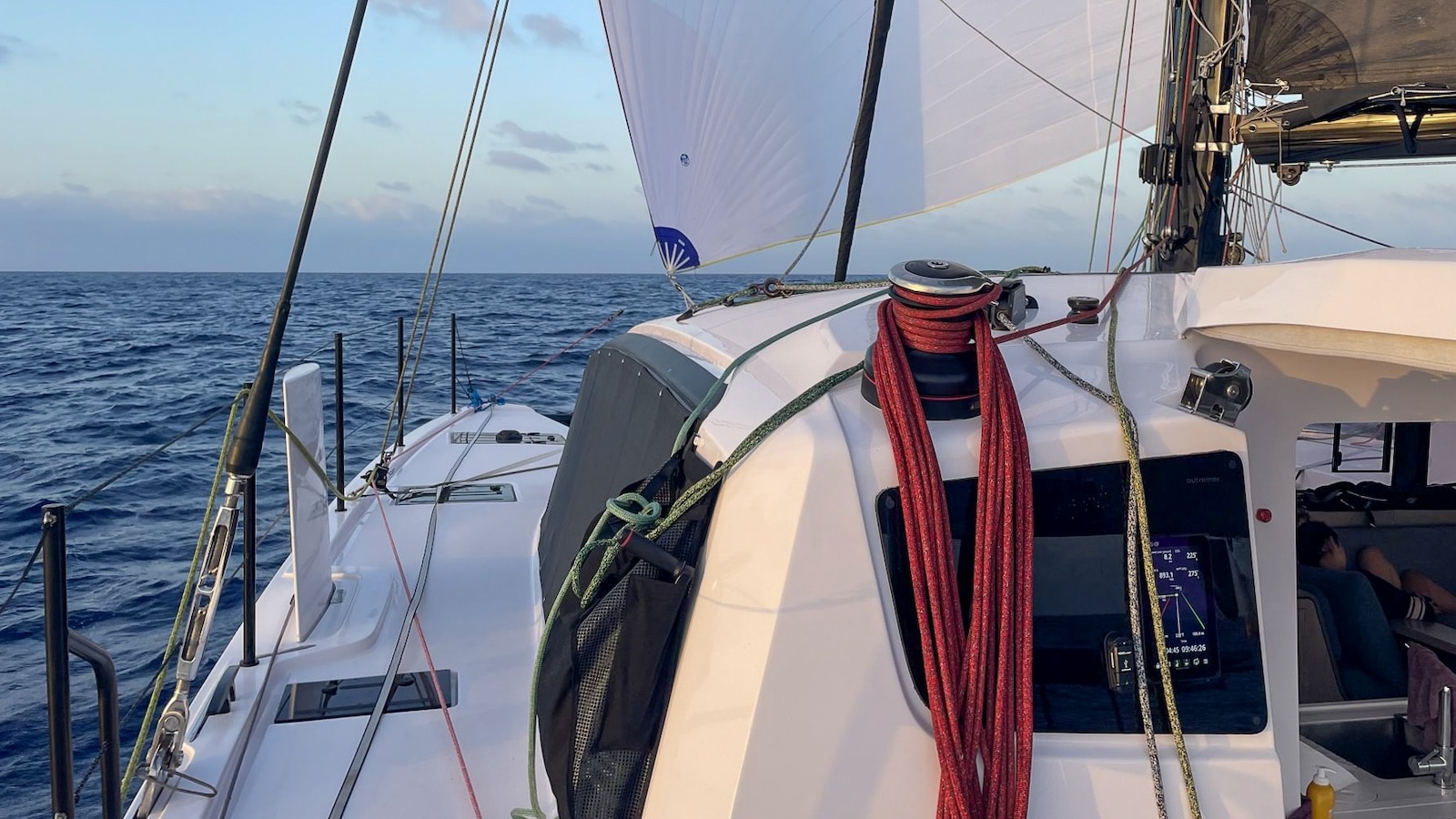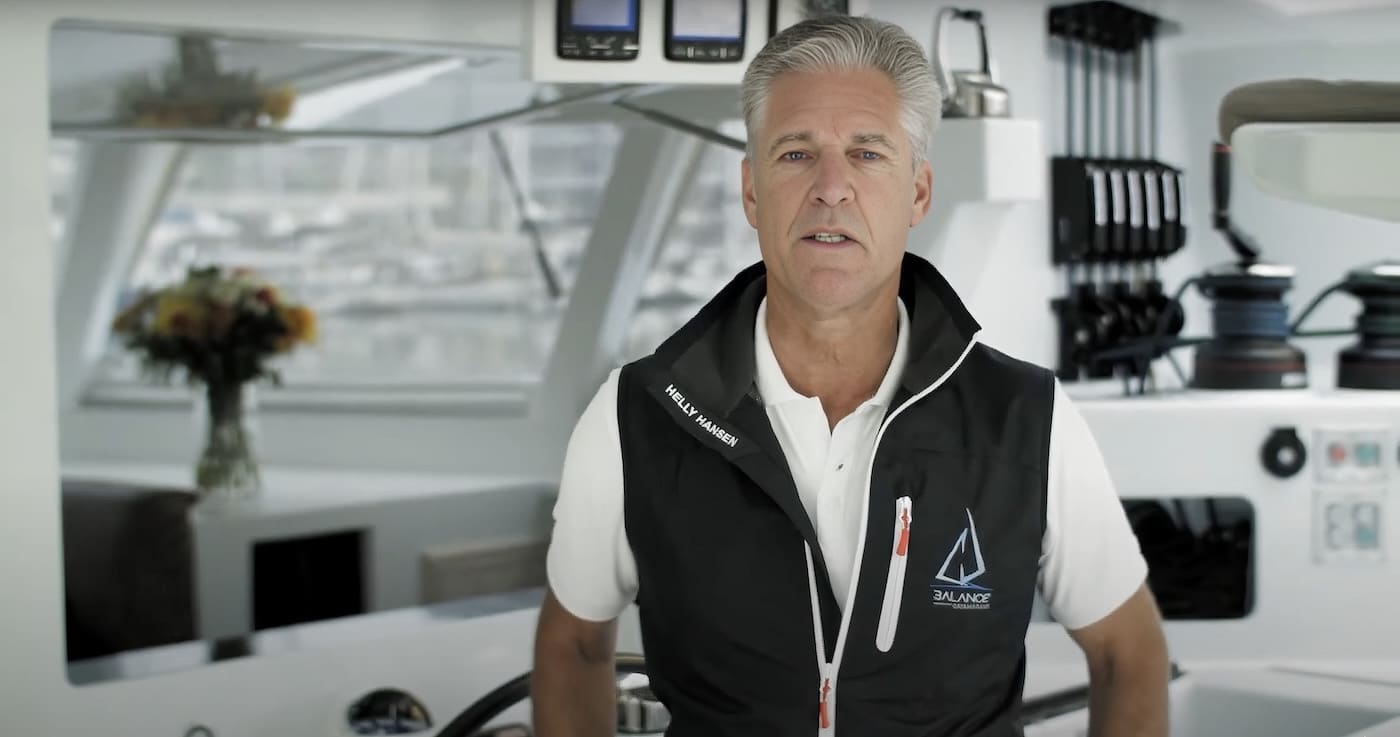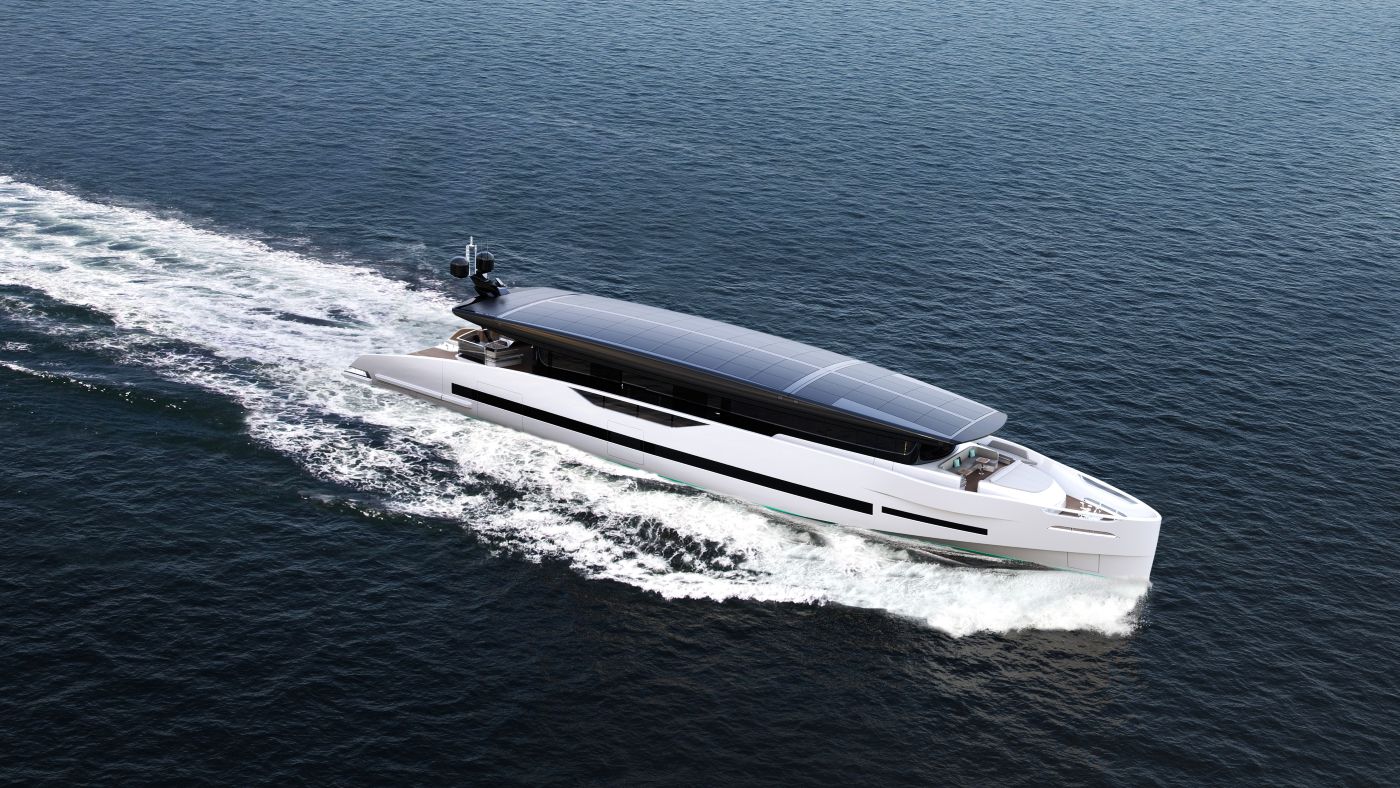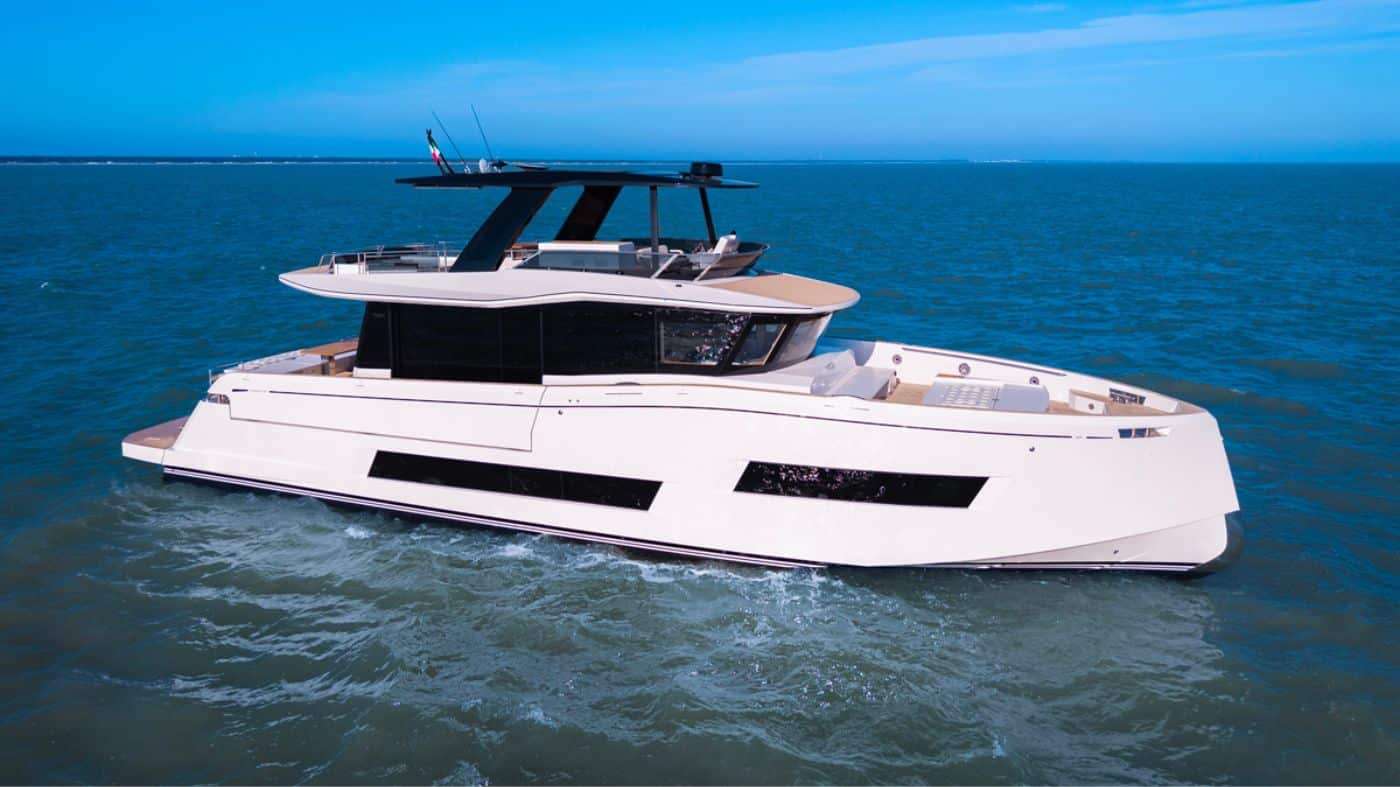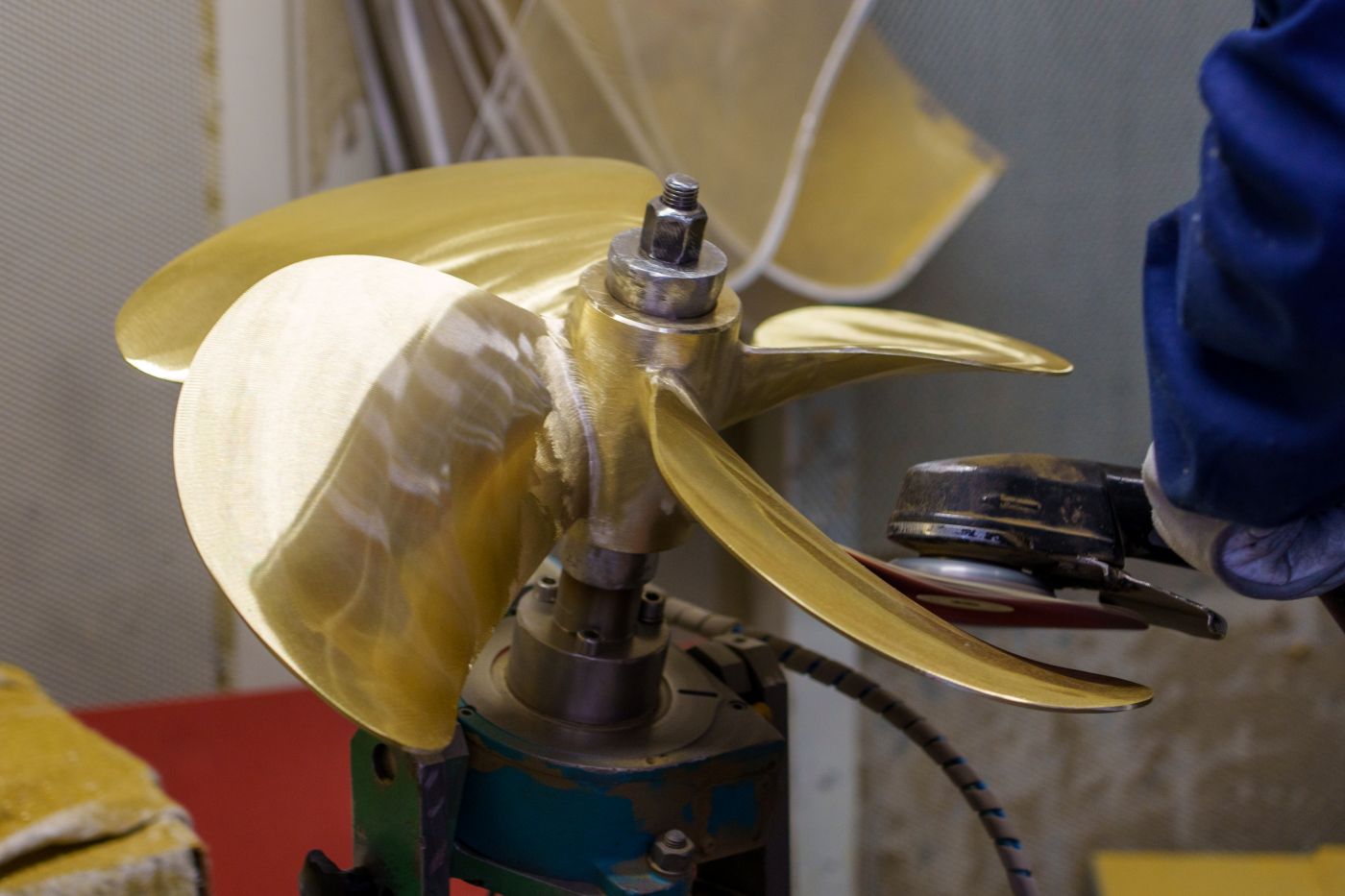Our Transatlantic Passage on our New Outremer 52
We made landfall after a 16-day sailing voyage across the Atlantic Ocean on January 5,2024 after spending the holidays at sea. This was the second leg in our All Together Maiden Voyage from La Grande Motte, France, through the Gibraltar Strait, to the Canary Islands, crossing to land in the Caribbean, then island hopping our way to Miami for a quick stop before our final destination for the season, the Bahamas. For all of us, it would also be our first-time celebrating Christmas and New Year’s at sea.
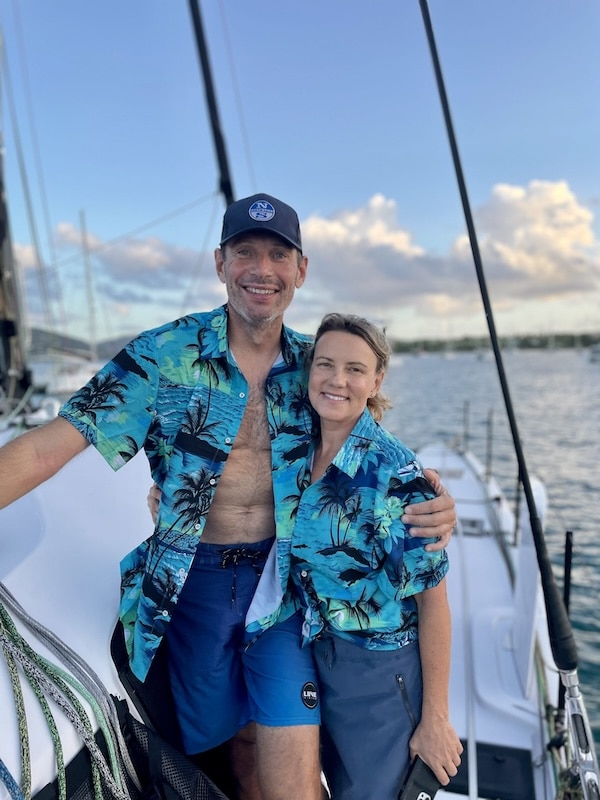
The sunrises were delicious, with colors only seen in a candy store, the Milky Way proudly revealing itself before the moonrise steals the show. However, only those things were constants during this transatlantic leg. We had hoped for well-established tradewinds that would deliver us quickly under the power of our asymmetrical spinnaker for most of the trip, but this was not our fate.
An abnormally positioned high pressure system further north disrupted the establishment of the trades just before we left. This turned an anticipated easy downwind voyage, into a more complex passage with a sideways and aggressive sea state out of the gate. If we went too far south, we wouldn’t have enough wind, if we headed just west, we would have worse conditions upwind. So, we needed a fine line to get through this first section of the trip. The good news is that this transatlantic passage offered the opportunity for a plethora of sail changes and learning experiences, which was the priority for this leg after all.
Onboard joining us as a skipper/instructor for this leg was Nikki Henderson, world renowned for her bluewater and racing experience but more important for us, her incredible teaching skills, and familiarity with the Outremer performance catamarans.
Our goal was that by having her onboard we could accelerate learning our boat, learn the nuances to safely maximize its performance, and help us round out our risk management plan so we could be prepared for any situation that went pear-shaped. Our intent was to take these learnings and apply them to how we wanted to sail together double handed going forward.
A Mutable Transatlantic Passage
There were three phases to this transatlantic passage, the sporty conditions leaving the Canaries, middle section with shifty winds, and the final approach where the trades reestablished themselves. We made the decision to leave with half tanks of fuel, with a preference to wait out wind holes but with enough of it to sensibly parlay with a ship in a medical emergency, charge batteries and get in and out of ports. While other boats chose to leave Las Palmas with full tanks and jerry cans lined on their decks, we made the decision to keep the boat light (with 220L) and sail through the conditions.
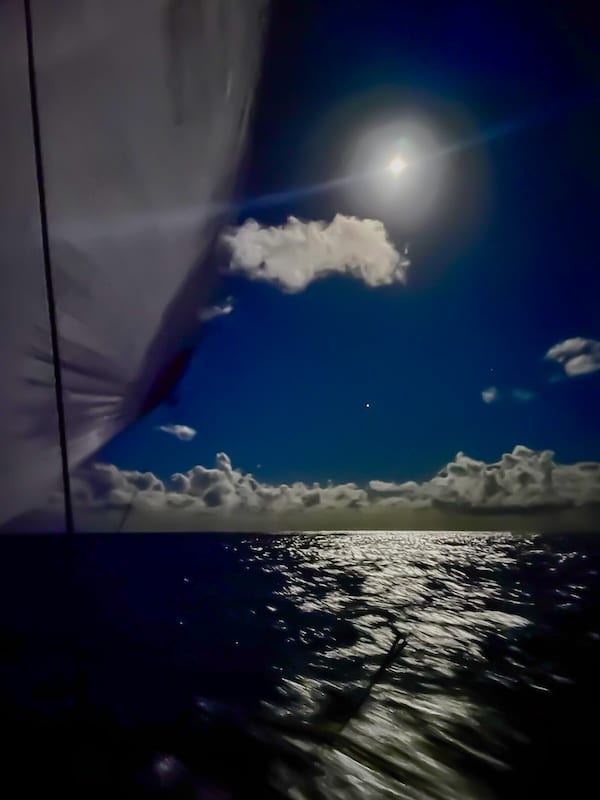
We got a chance to practice a water ingress drill (of course, in the middle of the night) because it was then we discovered a faulty hatch on a portlight allowed saltwater to enter.
A typical type of discovery in a shakedown. We hove-to and epoxied the seal shut and continued our journey. Those first few days we settled into the movement of the boat, learned and practiced downwind reefing, and began to work together as a team; all this before leaving the wind shadow of Tenerife.
The boat speed at this point, even in the challenging sea state, was averaging about 9 knots.
We finally shook off the reefs and raised the Code 65 as our direction shifted and we saw lighter winds.
Before leaving Las Palmas, we had a hunch about our preventer, so we had purchased supplies and were able to prepare a new one in these first couple of days.
That proved to be a smart decision because it ended up breaking twice later in the trip.
As the winds lightened and shifted, we raised the asymmetrical spinnaker, but it didn’t last long because we spent the next couple of days switching between the Code 65 and the asymmetrical A2 with the wind conditions; great experience for both of us dousing and hoisting the A2. The Code 65 was originally rigged for manual furling but during our neauvage (bringing the boat back to Outremer for final servicing after handover), we shifted it to the helm side of the boat and lengthened the line to allow for it to be furled single-handed from a winch if needed. During this time in our voyage, we averaged about 9.7 knots in 15.8 average knots of wind and saw 229 nautical miles in one day, a high point for sure.
By Christmas we were all very comfortable sailing the A2 spinnaker upwards of 18-20 knots of wind at night. While we had done an A2 overnight to Corsica earlier in the season and briefly during Leg 1 from La Grande Motte to Gibraltar, anxiety levels were high in the beginning. Nikki also rigged us a martin breaker system to release the tack that gave us and emergency break to douse quickly if we needed to and we changed our method from hand hoisting and dousing to using the winch on the bow. We also got a ton of practice with the gybing procedure double-handed, which was well worth the effort and time. We typically have done this using the autopilot to steer through the gybe, but I got more practice doing it manually while Stephane managed the sheets and main. Nikki also talked us through a letterbox douse in the event we needed to do one to absolutely get it down if all else failed. That’s when you slip the lazy sheet through the slot between the boom and the main and pull the kite through to the cockpit.
At this point in the transatlantic passage the full moon was spectacular, but elusive on camera. As the flying fish were busy doing kamikazes on deck for the next couple of days (and I don’t mean the drink), we found our expected wind hole. The direction too high to fly the spinnakers, we used the Code 65 which by this time had proven to be a very versatile sail. At 6.7 knots of wind speed, we were still able to do 5.6 SOG, which is truly remarkable and everything we had hoped for when we decided to switch to an Outremer from the production catamaran we had before.
Transatlantic Passage Energy Management
As we then sailed through the massive sargassum fields, we gave our hydrogenator (Watt & Sea) a break. This impacted our existing power plan since we used all the instruments at night, in addition to now having an extra freezer on board for the passage and heavier than expected use of Starlink. With the hydrogenator napping, we did need to run the engines to recharge when we approached 20% on our batteries for a few hours at night to kick it back up. It’s worth noting that we had expected to use Starlink maybe two hours per day to upload our daily vlog videos of the trip, but it could sometimes take two hours for it to connect to a satellite and then another two hours to upload the video for that day. We are still exploring what our power would be with normal use of Starlink, (without the video uploads) and 24×7 use of the hydrogenator, but at some point, we may need explore the idea of bigger alternators if we want to improve. With the sun angle and the position of the boom, it’s been a challenge to get the batteries up to full capacity during the day. The jury is still out on that.
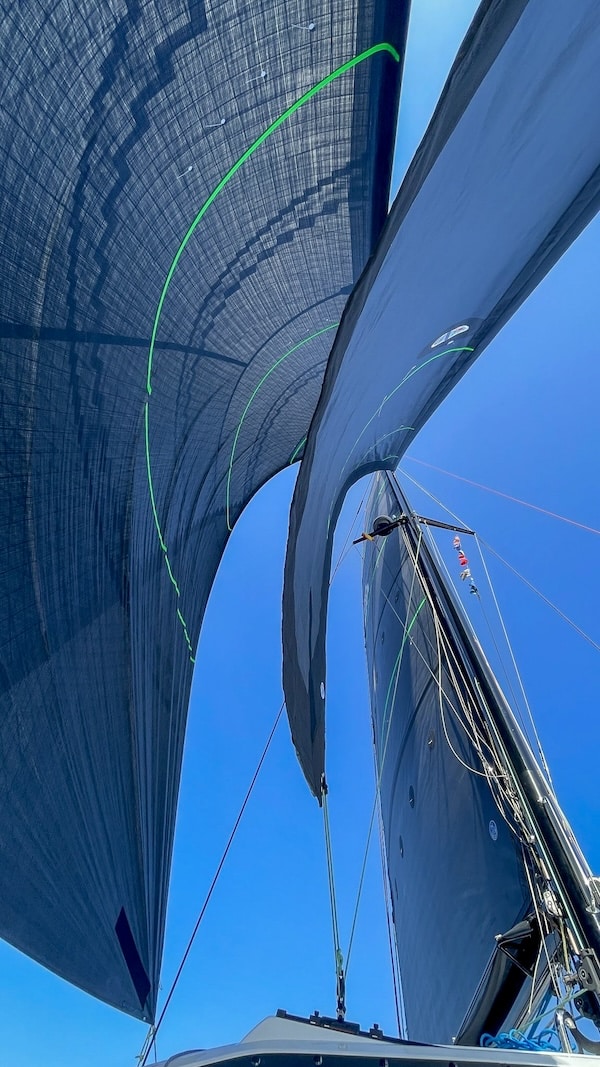
Long forgotten at this point of our transatlantic passage was our hats, socks, and puffer jackets as we marched towards the tropics. In just days we changed clocks and wardrobes now donning sunscreen and marveling at everyone’s dewy glow. On New Year’s Eve we bagged and stored the Code 65 as our passage moved to the next chapter. The wind picked back up and we were mostly flying the A2 pretty deep with the help of a guy. At 16 knots of wind, we were flying at about 10 knots boat speed and clocking the miles doing 90% of our polars on average. Over the next couple of days, we started keeping our eyes out for squalls and doused the A2 one night as one passed briefly overhead, giving the boat a much-welcomed shower.
After generous practice with our A2 gybes, we decided New Year’s Day was a great time for a brand-new sail, so we unwrapped the plastic from our red S4 symmetrical spinnaker. This proved to be an appropriate color as we managed to wrap it enthusiastically around the forestay because we hoisted it with the main still up. After a morning spent sliding it down the forestay (because untwisting it using traditional methods didn’t work), it had to be taken fully down and re-socked to hoist again. We doused the main downwind with our new downhaul method and re-hoisted the S4, which took on a personality change with the main out of the way. One of our followers suggested we name her ‘Sansa’, after the red-headed, demure damsel turned cunning warrior in Game of Thrones. Fitting indeed!
During the last couple of days of our transatlantic passage, we sailed mainly with the S4 up and the main down, like true cruisers. We gave ourselves a bit of a break from the more technical learning experience we had been having up to this point that included ambitious sail changes whenever the opportunities presented themselves. With high humidity setting in and sea temps reaching 29 C, we dropped below the 300 nautical mile mark to our destination. Sailing deep at 175, we are experiencing SOG half the speed of TWS, in our ‘easy mode’ which we were all happy with. For these days we were averaging just under 200 nautical miles a day with TWS between 12-17 knots.
We also got a nice lesson in tracking squalls and saw three in our area in just one night. We pulled the A2 down for a big one. Squalls will be a more regular thing in the Caribbean so getting a crash course in how to avoid them was a good idea.
Cuddling With Food
Rations aboard were plentiful, and even up to the last day of the transatlantic passage we enjoyed fresh apples, tomatoes, and red cabbage. We gobbled up two tubs of ice cream (it was after all the holidays), and went through approximately 80 chocolate bars, (or so it seemed), 6 pounds of coffee, five smartly rationed bags of tortilla chips and freshly made salsa to match. We had many more bags of chips and salty snacks, but tortilla chips were a welcomed treat. We enjoyed fresh meals every day and treated ourselves to a freshly baked chocolate cake to celebrate the new year. Our portable freezer allowed us to enjoy frozen fruit smoothies in the final days to match our Caribbean music playlist to get us in the island vibe. For those of us who relish a good nap during the day (which was everyone but Stephane), the crew was well rested and refreshed for watches, convivial conversation, brief workouts, and learning moments.
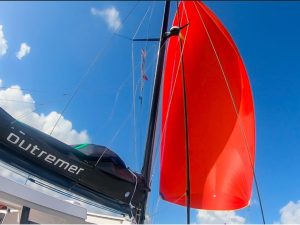
Then, late afternoon our very last day of the transatlantic passage, we decided to do a ‘quad’ maneuver. The goal was to put the A2 back up to dry it out and do our final approach with only one more night gybe.
The ‘quad’ meant dousing the S4, unfurling the genoa, raising the main, furling the genoa, and hoisting then flying the A2: a four sail maneuver. This was our final exam to graduate from the school of Nikki Henderson Sailing!
After a successful maneuver we approached the southern cape of Martinique at a galloping pace of 12-15 knots boat speed, 16.9 at one point. It felt like AWEN was excited to sunbath and let the anchor take over.
Transatlantic Passage Wrap-Up
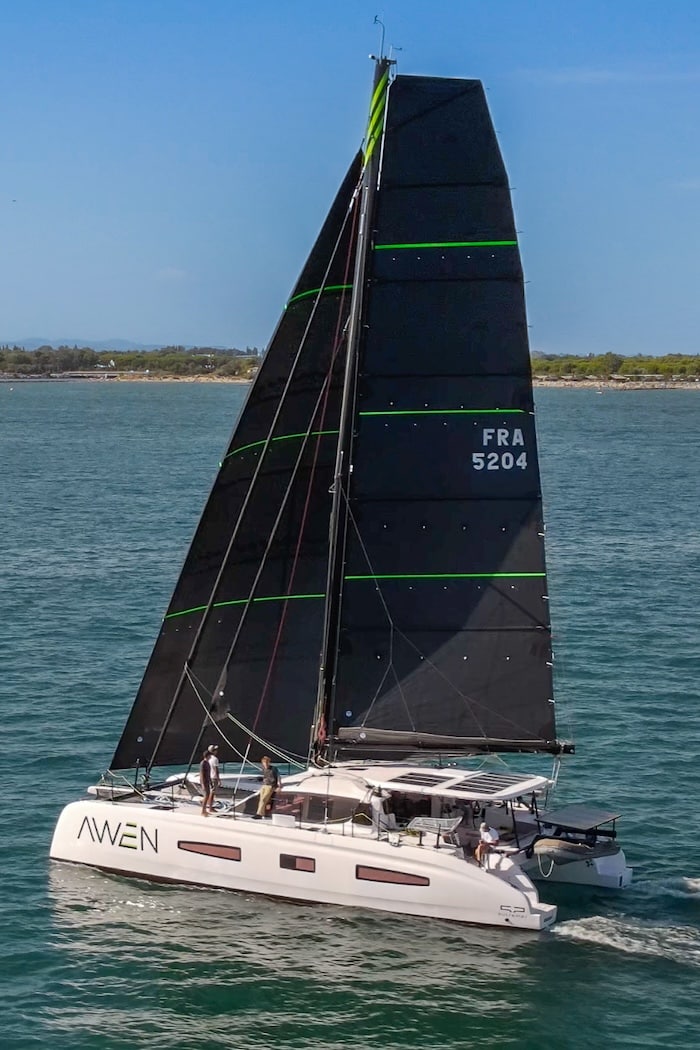
In the end, we made landfall 16 days from Las Palmas to Martinique, across the Atlantic Ocean 3,008 nautical miles and about a zillion sail changes. We only motored in and out of the marina/anchorage and we had 7.7 average boat speed, max boat speed 21.2, average wind 13.3 knots. Unlike most transatlantic passages, we crossed mostly on a port tack. We arrived just before sunrise to enjoy the pleasure of jumping into the inviting ocean safely, the smell of lush island surrounding us, wrapped in the arms of sweet civilization.
AWEN, our Outremer 52, has been everything we ever wanted in a performance boat. She’s dexterous in many wind conditions, responsive, communicates her needs, protects us from the powerful impact and noise of the waves by streamlining through the water like an Olympic swimmer and softly surfing them from astern.
While performance sailing is more technical, with many lines for many sails in many conditions, the layout is simple and intuitive to manage.
The helm is balanced and quick to respond, the bow and hulls are light and stiff, and the rig is firm and regal. It shines in downwind sailing, hustles in the angles, and softens the discomfort of upwind sailing which is the dream of any bluewater cruiser; we absolutely love her.
‘AWEN’ is an old Breton word that means ‘the soft breeze that inspires you’ and she certainly does.
In Martinique we arrived heavily bronzed, much more confident in our seamanship, and possessing an epic amount of trust in our boat which was an absolute champ!
And…as I was completing this article, the local dolphins arrived right on cue on our starboard side with 150 nautical miles left to go in our transatlantic passage, after traveling 2,843 so far. I wonder if they mistake our AWEN as a gentle giant to play with in the surf and they jump and dive alongside her hulls. As they speed away to bring joy to the next arriving crew, my heart is full of gratitude for this ocean, our sailboat, our crew, and the experience this passage has given us.
Experience the passage yourself! You can get a real feeling for what the transatlantic passage was like by checking out our daily videos capturing the experience real time.

